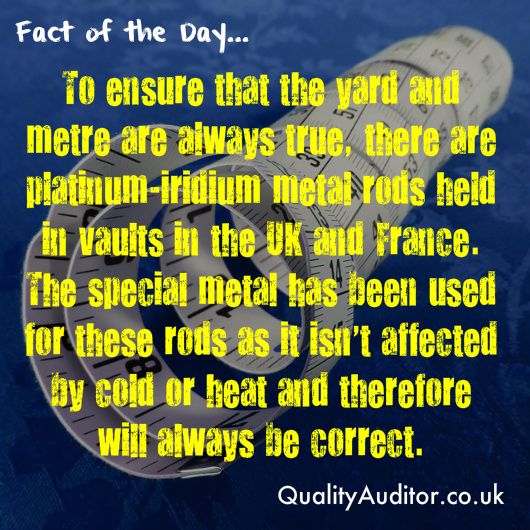Calibration advice
 Anne Barber
·
3 minute read
Anne Barber
·
3 minute read
Since I became involved in Quality and Environmental Management I have been asked about calibration and whether it is necessary, no matter whether it was in semi-conductor, high volume ink jet cartridge, printer manufacturing or building and construction works.
There seems to be a fear of calibration and what it involves. Will it be expensive? Will I have to buy more equipment? And also, can I exclude my organisation from this part of the Standard?
This article should go some way to help you understand the ‘why’ behind the requirement for calibration and also allay any fears you might have around the ‘what’ should be calibrated and ‘when’.
You can research the history of calibration on Wikipedia; however a quick note on some of the earliest noted calibration methods. A subdivision of ‘cubit’ (a hand) was used to measure horses; however the size of the ‘hand’ could vary depending on the size of the person doing the measuring. Not a very effective measure and that is why a ‘hand’ is now a standard 4 inches. It was not until the time of the Magna Carta that the UK Yard, foot and inch was laid down as standard and not until 1889 that the Standard Metre was defined.
History has its place and we can all learn from what has gone before; however calibration has come a long way from Imperial and Metric measurement. We now need to look at calibrating electrical meters, medical equipment, torque wrenches and so on – too many pieces of equipment to mention here.
Why calibrate? An example from Silicon Glen...
I worked in the semi-conductor industry and a large part of the ISO9001 Quality Management System was the ongoing calibration of all the equipment. The management team picked up that the cost of calibrating the multi-meters was quite expensive. The meters were used by engineers and technicians during their maintenance of the very sophisticated equipment needed to produce semi-conductors. Each had their own meter and was responsible for handing it in for its annual calibration check or if they thought it wasn’t working correctly. However, the process was not robust as the meters were often lost, broken or never handed in for calibration.
One day an engineer forgot to take his meter into the FAB (Semiconductor Wafer Fabrication Area) with him and instead of ‘making the effort’ to go back and get his own one, saw a meter lying on a shelf. He was just about to go ahead and test the piece of equipment to confirm it had been shut down in preparation for the work he was going to carry out when, luckily for him, another engineer came along and saw what he was going to do and stopped him. The meter was broken and would have shown no power when, in fact, the equipment was still ‘live’. Had he gone ahead and started to work on the equipment he could have, at the least been seriously injured or, died.
As a result of this incident, the management team agreed a new process to ensure that all multi-meters were handed in for calibration.

What should you be calibrating?
Each organisation shall have different equipment that requires to be calibrated so no easy answer here! If you need to ensure that your product or service conforms to customer requirements and these are measurable then you need to identify what you use to ensure repeatability in your processes. Size, weight, time – all can be measured and the equipment you use to manage these requirements needs to be calibrated to ensure conformity and consistency.
It doesn’t matter if it is a torque wrench, an electrical meter or a set of scales, if they can affect the end result of your process then they need to be calibrated.
When, and how often?
If you purchase new calibrated equipment then it should have its Calibration Certificate as part of the paperwork you receive. The certificate shows the date the equipment was calibrated and the manufacturer’s recommended recalibration date. Not all equipment needs to be recalibrated once a year. Factors that can affect recalibration dates can be your operating environment, the accuracy requirements of your process or how long your instrument stays true (in calibration).
Other factors to consider are how many similar pieces of calibrated equipment you need to ensure you can always have enough to keep you working when one is out for recalibration. An example of this is when I was responsible for an extremely expensive ‘calibrated light source’. The unit needed to be sent to Japan for recalibration and it could take 3 months! We needed to have the light source available every day and therefore we needed to spend the money to purchase a second unit. They were then set up to be recalibrated on the opposing 6 months to ensure that we always had at least one unit available. Expensive but necessary. Tip here is to work out what you need and then make sure you can have them recalibrated in such a way that you have enough to allow you to continue with your processes when equipment is removed for recalibration.
You will need to source, preferably a local, NAMAS (National Measurement Accreditation Service) organisation that can recalibrate your equipment. You might find you need more than one organisation, as not all of them can calibrate every type of equipment. If you are using electrical equipment then you might need to find an NPL (National Physical Laboratory) organisation.
Lastly... keeping track
You don’t need an expensive system to keep track of your calibration equipment. An Excel spreadsheet set up with each piece of equipment and its recall date is all you need. By setting up filters then you can check each month to make sure you know when to send equipment for recalibration.



